
|
Bright new comet discovered in the SWAN images. It brightened rapidly up to 7.8 mag on Apr. 8 (Osamu Miyazaki). Then it has been fading before the perihelion passage. Now it is 10.7 mag (May 1, Thomas Lehmann). Fading rapidly. It will be fainter than 18 mag in August. In the Northern Hemisphere, it will never be observable after this. It locates somewhat low in the Southern Hemisphere. But it will become high in summer.
Date(TT) R.A. (2000) Decl. Delta r Elong. m1 Best Time(A, h)
May 10 4 41.78 11 0.1 1.030 0.421 23 11.7 18:36 (106, 5)
May 17 5 4.40 -0 6.4 1.137 0.556 29 12.6 18:31 ( 97, 11)
|

|
It is visible at 11 mag in the SWAN images (Jan. 27, Vladimir Bezugly). It will fade out rapidly after this. Now it is not observable. It will appear in July in the Southern Hemisphere, or in September in the Northern Hemisphere.
Date(TT) R.A. (2000) Decl. Delta r Elong. m1 Best Time(A, h)
May 10 3 31.82 6 51.4 2.165 1.197 12 12.3 18:36 ( 94, -7)
May 17 3 57.82 6 46.8 2.210 1.250 13 12.6 18:31 ( 94, -6)
|

|
It brightened up to -3 mag due to the forward scattering on Oct. 9 in the SOHO coronagraph images (Q.-c. Zhang, Charles S. Morris). It became a great comet of 0 mag on the ground. Now it is 12.6 mag (Apr. 26, Hiroshi Abe). Fading slowly. In the Northern Hemisphere, it stays observable in good condition. It locates somewhat low in the Southern Hemisphere. But it will become high in spring.
Date(TT) R.A. (2000) Decl. Delta r Elong. m1 Best Time(A, h)
May 10 20 7.19 25 22.0 3.476 3.710 95 13.0 4:56 (180, 30)
May 17 20 0.35 26 23.2 3.467 3.793 101 13.0 4:22 (180, 29)
|

|
It approached to Sun down to 0.09 a.u. on Jan. 13. It brightened up to -2 or -3 mag and it was detected even in the daylight. The nucleus was disintegrated on Jan. 19. However, its remnant is still visible. Fading gradually. In the Northern Hemisphere, it will never be observable after this. In the Southern Hemisphere, it stays observable in good condition.
Date(TT) R.A. (2000) Decl. Delta r Elong. m1 Best Time(A, h)
May 10 2 2.30 -49 13.8 2.728 2.535 68 13.2 5:16 (312, 29)
May 17 2 14.33 -50 40.7 2.767 2.639 72 13.4 5:21 (312, 33)
|

|
Now it is 14.0 mag (Apr. 14, B. Lutkenhoner). Fading gradually. In the Northern Hemisphere, it is not observable now, but it will appear in July. It stays extremely low in the Southern Hemisphere. But it will become high in autumn.
Date(TT) R.A. (2000) Decl. Delta r Elong. m1 Best Time(A, h)
May 10 1 26.54 2 20.1 2.024 1.241 29 13.4 5:16 (259, 11)
May 17 1 52.56 4 21.3 2.013 1.231 29 13.3 5:21 (257, 11)
|
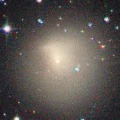
|
Now it is 13.0 mag (Apr. 30, Osamu Miyazaki). It will be getting lower gradually after this, and it will be unobservable in July in the Northern Hemisphere, or in August in the Southern Hemisphere.
Date(TT) R.A. (2000) Decl. Delta r Elong. m1 Best Time(A, h)
May 10 9 37.55 10 40.6 6.126 6.276 93 13.9 18:36 (176, 44)
May 17 9 39.08 10 32.4 6.239 6.277 87 14.0 18:31 (169, 44)
|

|
Now it is 13.6 mag (May 4, Hirohisa Sato). It stays 14 mag for a while. It stays observable in good condition.
Date(TT) R.A. (2000) Decl. Delta r Elong. m1 Best Time(A, h)
May 10 15 20.24 -6 35.8 4.325 5.319 168 13.9 0:11 (180, 62)
May 17 15 17.32 -5 42.1 4.351 5.338 165 14.0 23:36 (180, 61)
|

|
Now it is 14.9 mag (Feb. 4, Alfons Diepvens). It stays 14 mag for a while. In the Northern Hemisphere, it is not observable now, but it will be observable soon. It locates somewhat low in the Southern Hemisphere.
Date(TT) R.A. (2000) Decl. Delta r Elong. m1 Best Time(A, h)
May 10 1 29.60 13 32.7 4.796 3.894 23 14.3 5:16 (251, 4)
May 17 1 38.43 14 28.3 4.745 3.883 28 14.3 5:21 (246, 7)
|
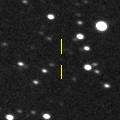
|
Fading slowly. In the Northern Hemisphere, it is not observable now, but it will appear in June. In the Southern Hemisphere, it will be getting higher gradually.
Date(TT) R.A. (2000) Decl. Delta r Elong. m1 Best Time(A, h)
May 10 0 55.46 -2 58.9 2.772 2.078 38 14.4 5:16 (259, 20)
May 17 1 9.93 -1 49.2 2.742 2.092 41 14.4 5:21 (255, 23)
|

|
Now it is 14.5 mag (Apr. 21, Hiroshi Abe). It will fade out rapidly after this. It will be fainter than 18 mag in September. It will be unobservable in July.
Date(TT) R.A. (2000) Decl. Delta r Elong. m1 Best Time(A, h)
May 10 5 50.11 22 2.7 2.117 1.468 38 14.5 18:36 (126, 10)
May 17 6 14.17 23 6.4 2.160 1.487 37 14.6 18:31 (127, 9)
|
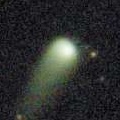
|
It was observed at 12-13 mag for a long time in 2024. Now it is 14.6 mag (Apr. 29, Ken-ichi Kadota). It stays 15 mag for a while. In the Northern Hemisphere, it will be getting higher gradually. In the Southern Hemisphere, it is not observable now.
Date(TT) R.A. (2000) Decl. Delta r Elong. m1 Best Time(A, h)
May 10 1 48.21 48 47.5 5.016 4.230 35 14.6 5:16 (224,-20)
May 17 1 50.15 49 12.3 5.030 4.261 36 14.6 5:21 (220,-16)
|

|
Now it is 14.8 mag (Apr. 24, Andrew Pearce). It stays 15 mag for a while. It will be unobservable in June. But it will be observable again in August.
Date(TT) R.A. (2000) Decl. Delta r Elong. m1 Best Time(A, h)
May 10 6 46.29 16 3.9 6.112 5.552 52 14.9 18:36 (132, 23)
May 17 6 51.64 16 26.5 6.187 5.544 46 14.9 18:31 (129, 20)
|
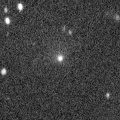
|
Very large comet. It is expected to brighten up to 13 mag in 2031. Now it is 15.4 mag (Apr. 30, Andrew Pearce). It stays 15 mag for a while. In the Northern Hemisphere, it is not observable now. In the Northern Hemisphere, it is not observable until 2030.
Date(TT) R.A. (2000) Decl. Delta r Elong. m1 Best Time(A, h)
May 10 4 14.37 -65 25.4 15.232 15.159 83 15.2 18:36 ( 30, 34)
May 17 4 19.58 -65 22.9 15.189 15.136 85 15.2 18:31 ( 30, 32)
|

|
Brightened rapidly. Now it is 14.6 mag (Jan. 31, Thomas Lehmann). Fading slowly. It stays extremely low in the Northern Hemisphere. But it will become high in summer. In the Southern Hemisphere, it will be getting higher gradually.
Date(TT) R.A. (2000) Decl. Delta r Elong. m1 Best Time(A, h)
May 10 1 10.78 14 1.5 2.753 1.923 28 15.2 5:16 (247, 7)
May 17 1 23.39 12 47.5 2.735 1.954 32 15.3 5:21 (245, 11)
|

|
It brightened up to 12.7 mag in 2024 summer (Aug. 7, 2024, Thomas Lehmann). Now it is 14.9 mag (Apr. 30, Toshiyuki Takahashi). It stays 16 mag for a while. In the Northern Hemisphere, it stays observable in good condition. In the Southern Hemisphere, it will be unobservable in August.
Date(TT) R.A. (2000) Decl. Delta r Elong. m1 Best Time(A, h)
May 10 23 8.62 28 55.8 3.493 3.036 55 15.3 5:16 (216, 16)
May 17 23 15.19 31 16.8 3.477 3.083 59 15.4 5:21 (210, 16)
|

|
Now it is 14.9 mag (Apr. 26, Toshihiko Ikemura, Hirohisa Sato). Fading slowly. It will be getting lower gradually after this, and it will be unobservable in July in the Northern Hemisphere, or in August in the Southern Hemisphere.
Date(TT) R.A. (2000) Decl. Delta r Elong. m1 Best Time(A, h)
May 10 11 44.68 -13 53.1 2.730 3.480 131 15.3 20:31 (180, 69)
May 17 11 33.82 -11 48.2 2.852 3.491 121 15.4 19:52 (180, 67)
|
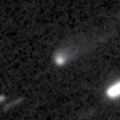
|
Now it is 16.4 mag (Apr. 29, ATLAS Chile). It stays 15 mag for a while. It locates somewhat low in the Northern Hemisphere. In the Southern Hemisphere, it stays observable in good condition.
Date(TT) R.A. (2000) Decl. Delta r Elong. m1 Best Time(A, h)
May 10 19 0.47 -27 55.2 2.225 2.932 125 15.4 3:50 (180, 83)
May 17 19 0.88 -28 23.2 2.152 2.930 132 15.3 3:23 (180, 83)
|

|
Now it is 16.5 mag (Apr. 7, Alfons Diepvens). It stays 15 mag for a while. Now it is not observable. It will appear in August.
Date(TT) R.A. (2000) Decl. Delta r Elong. m1 Best Time(A, h)
May 10 4 44.41 20 13.1 3.419 2.522 23 15.4 18:36 (115, -1)
May 17 4 58.40 20 23.8 3.439 2.510 19 15.4 18:31 (113, -2)
|

|
It brightened up to 14.4 mag in winter (Feb. 4, Ken-ichi Kadota). Now it is 16.5 mag (Apr. 26, Masayoshi Yoshimi). Fading slowly. It will be getting lower gradually after this, and it will be unobservable in July in the Northern Hemisphere, or in September in the Southern Hemisphere.
Date(TT) R.A. (2000) Decl. Delta r Elong. m1 Best Time(A, h)
May 10 9 5.30 13 14.4 2.537 2.658 85 15.5 18:36 (166, 41)
May 17 9 13.11 12 29.1 2.631 2.665 80 15.6 18:31 (161, 41)
|

|
Now it is 15.4 mag (Apr. 26, Toshihiko Ikemura, Hirohisa Sato). Fading slowly. It locates somewhat low in the Northern Hemisphere. In the Southern Hemisphere, it stays observable in good condition.
Date(TT) R.A. (2000) Decl. Delta r Elong. m1 Best Time(A, h)
May 10 13 6.63 -29 44.1 2.765 3.673 149 15.6 21:53 (180, 85)
May 17 13 6.35 -28 36.2 2.816 3.690 144 15.6 21:25 (180, 84)
|

|
It is expected to brighten up to 13 mag in early summer in 2026. Now it is 16.0 mag (Apr. 26, Hiroshi Abe). Brightening slowly. In the Northern Hemisphere, it stays observable in good condition. It locates somewhat low in the Southern Hemisphere. But it will become high in autumn.
Date(TT) R.A. (2000) Decl. Delta r Elong. m1 Best Time(A, h)
May 10 22 35.05 21 41.1 5.025 4.667 63 15.7 5:16 (213, 26)
May 17 22 33.60 22 16.5 4.882 4.629 69 15.6 5:21 (205, 28)
|

|
It is expected to brighten up to 5 mag in 2026 January. Now it is 16.3 mag (May 4, ATLAS-HKO, Haleakala). Brightening gradually. In the Northern Hemisphere, it stays observable in good condition. In the Southern Hemisphere, it is not observable now, but it will appear in July.
Date(TT) R.A. (2000) Decl. Delta r Elong. m1 Best Time(A, h)
May 10 18 14.53 55 34.8 3.695 3.946 96 15.8 3:04 (180, -1)
May 17 18 7.09 56 32.2 3.598 3.866 97 15.7 2:29 (180, -2)
|

|
It will brighten up to 13 mag in 2026. Now it is 15.9 mag (Apr. 29, Ken-ichi Kadota). It stays 15 mag for a while. It stays observable in good condition.
Date(TT) R.A. (2000) Decl. Delta r Elong. m1 Best Time(A, h)
May 10 19 46.14 -21 27.9 5.597 6.088 114 15.8 4:36 (180, 76)
May 17 19 44.17 -20 59.0 5.452 6.046 121 15.7 4:06 (180, 76)
|

|
First return of a new periodic comet which brightened up to 15 mag in 2010. Now it is 15.7 mag (Apr. 21, Ken-ichi Kadota). It will fade out rapidly after this. It will be fainter than 18 mag in July. In the Northern Hemisphere, it will be getting lower gradually. It stays extremely low in the Southern Hemisphere.
Date(TT) R.A. (2000) Decl. Delta r Elong. m1 Best Time(A, h)
May 10 7 37.11 34 30.2 1.999 1.764 61 15.9 18:36 (153, 14)
May 17 7 59.82 33 31.5 2.073 1.796 60 16.1 18:31 (152, 15)
|

|
Now it is 16.0 mag (Apr. 30, Andrew Pearce). It stays 16 mag for a while. It will be unobservable in June in the Northern Hemisphere, or in September in the Southern Hemisphere.
Date(TT) R.A. (2000) Decl. Delta r Elong. m1 Best Time(A, h)
May 10 10 53.42 -35 39.2 4.643 5.242 121 16.0 19:40 ( 0, 89)
May 17 10 48.00 -34 0.9 4.734 5.249 115 16.1 19:07 (180, 89)
|

|
Now it is 15.9 mag (Apr. 30, Ken-ichi Kadota). It stays 16 mag for a while. In the Northern Hemisphere, it stays observable in good condition. In the Southern Hemisphere, it will never be observable after this.
Date(TT) R.A. (2000) Decl. Delta r Elong. m1 Best Time(A, h)
May 10 10 39.54 65 50.1 4.339 4.333 82 16.1 19:27 (180,-11)
May 17 10 36.83 65 43.7 4.412 4.328 78 16.1 18:57 (180,-11)
|

|
Now it is 16.4 mag (Apr. 30, Ken-ichi Kadota). It stays 17 mag for a while. It will be unobservable in June. But it will be observable again in August in the Northern Hemisphere.
Date(TT) R.A. (2000) Decl. Delta r Elong. m1 Best Time(A, h)
May 10 6 44.32 11 36.2 4.415 3.887 52 16.4 18:36 (128, 26)
May 17 6 48.60 12 51.0 4.503 3.883 46 16.4 18:31 (125, 22)
|

|
Now it is 16.1 mag (Apr. 29, ATLAS Chile). It stays 16 mag for a while. It will be unobservable soon in the Northern Hemisphere, or in July in the Southern Hemisphere. But it will be observable again in July in the Southern Hemisphere, or in September in the Northern Hemisphere.
Date(TT) R.A. (2000) Decl. Delta r Elong. m1 Best Time(A, h)
May 10 7 1.98 -14 35.7 6.948 6.606 66 16.4 18:36 (108, 48)
May 17 7 6.27 -13 53.4 7.020 6.601 61 16.4 18:31 (105, 43)
|

|
Now it is 17.1 mag (May 7, ATLAS Chile). Brightening slowly. In the Northern Hemisphere, it will be getting higher gradually. In the Southern Hemisphere, it stays observable in good condition.
Date(TT) R.A. (2000) Decl. Delta r Elong. m1 Best Time(A, h)
May 10 22 41.02 -17 18.0 3.084 2.972 74 16.7 5:16 (248, 55)
May 17 22 48.70 -16 31.8 2.983 2.959 78 16.6 5:21 (240, 59)
|
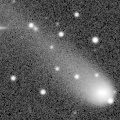
|
Now it is 16.4 mag (May 4, ATLAS South Africa). It stays 17 mag for a while. In the Northern Hemisphere, it is not observable now, but it will appear in September. In the Southern Hemisphere, it will be getting lower gradually. But it will be getting higher again after June.
Date(TT) R.A. (2000) Decl. Delta r Elong. m1 Best Time(A, h)
May 10 5 29.48 -37 29.9 7.732 7.353 64 16.7 18:36 ( 67, 39)
May 17 5 31.75 -37 4.5 7.806 7.397 62 16.8 18:31 ( 66, 35)
|

|
It brightened up to 13.8 mag in winter (Dec. 30, Thomas Lehmann). Now it is 17.2 mag (May 2, Toshihiko Ikemura, Hirohisa Sato). Fading slowly. It will be fainter than 18 mag in July. In the Northern Hemisphere, it will be getting lower gradually. It stays extremely low in the Southern Hemisphere.
Date(TT) R.A. (2000) Decl. Delta r Elong. m1 Best Time(A, h)
May 10 9 1.75 43 47.7 3.146 3.080 77 16.9 18:36 (172, 11)
May 17 9 10.96 41 49.0 3.263 3.120 72 17.0 18:31 (169, 12)
|
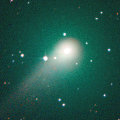
|
It was observed at 9-10 mag for a long time in 2023. Now it is 16.3 mag (Apr. 23, ATLAS Chile). It stays 17 mag for a while. In the Northern Hemisphere, it will never be observable after this. In the Southern Hemisphere, it stays observable in good condition.
Date(TT) R.A. (2000) Decl. Delta r Elong. m1 Best Time(A, h)
May 10 22 19.93 -65 43.7 7.134 7.356 98 16.9 5:16 (340, 55)
May 17 22 18.91 -66 39.2 7.109 7.408 103 17.0 5:21 (346, 56)
|
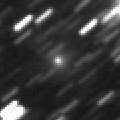
|
Very far object. Now it is 16.9 mag (Dec. 20, ATLAS Chile). It stays 17 mag for a while. In the Northern Hemisphere, it is not observable now. In the Southern Hemisphere, it stays observable in good condition.
Date(TT) R.A. (2000) Decl. Delta r Elong. m1 Best Time(A, h)
May 10 1 21.52 -53 14.0 10.938 10.710 74 17.0 5:16 (314, 37)
May 17 1 23.79 -53 12.1 10.888 10.720 77 17.0 5:21 (313, 41)
|

|
It will brighten up to 9 mag in 2026 spring. Now it is 17.3 mag (Apr. 30, Andrew Pearce). Brightening slowly. In the Northern Hemisphere, it will be getting lower gradually after this, and it will be unobservable in August. In the Southern Hemisphere, it stays observable in good condition.
Date(TT) R.A. (2000) Decl. Delta r Elong. m1 Best Time(A, h)
May 10 10 17.62 15 31.0 2.700 3.063 101 17.1 19:05 (180, 40)
May 17 10 19.19 15 9.7 2.761 3.024 95 17.0 18:39 (180, 40)
|
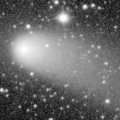
|
It brightened up to 9.6 mag from February to March in 2024 (Feb. 25, 2024, Thomas Lehmann). Now it is 17.6 mag (May 2, W. Hasubick). It stays 17 mag for a while. In the Northern Hemisphere, it stays observable in good condition. It stays extremely low in the Southern Hemisphere.
Date(TT) R.A. (2000) Decl. Delta r Elong. m1 Best Time(A, h)
May 10 23 28.63 38 10.8 6.016 5.448 51 17.1 5:16 (214, 5)
May 17 23 32.44 38 53.1 6.023 5.511 55 17.1 5:21 (209, 8)
|
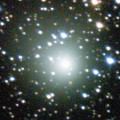
|
It brightened up to 8.3 mag in 2021-2022 winter (Jan. 6, 2022, Toshiyuki Takahashi). Now it is 18.9 mag (Apr. 14, Jean-Claude Merlin). It stays 18 mag for a while. In the Northern Hemisphere, it will never be observable after this. In the Southern Hemisphere, it stays observable in good condition.
Date(TT) R.A. (2000) Decl. Delta r Elong. m1 Best Time(A, h)
May 10 11 53.64 -58 17.2 9.545 10.172 126 17.1 20:40 ( 0, 67)
May 17 11 52.08 -57 48.0 9.612 10.216 124 17.1 20:11 ( 0, 67)
|

|
It returned for the first time in 68 years. It brightened up to 6.2 mag in early last summer (July 1, Virgilio Gonano). Now it is 16.3 mag (Apr. 29, ATLAS Chile). It will fade out rapidly after this. It will be fainter than 18 mag in June. It locates somewhat low in the Northern Hemisphere. In the Southern Hemisphere, it stays observable in good condition.
Date(TT) R.A. (2000) Decl. Delta r Elong. m1 Best Time(A, h)
May 10 18 37.94 -25 19.4 3.309 4.040 130 17.2 3:28 (180, 80)
May 17 18 33.29 -25 59.1 3.293 4.105 138 17.3 2:56 (180, 81)
|

|
Now it is 16.8 mag (Apr. 29, Yukihiro Sugiyama). It stays 18 mag for a while. In the Northern Hemisphere, it will be unobservable in July. In the Southern Hemisphere, it stays observable in good condition.
Date(TT) R.A. (2000) Decl. Delta r Elong. m1 Best Time(A, h)
May 10 11 10.77 -31 42.1 4.710 5.354 125 17.2 19:57 (180, 87)
May 17 11 7.86 -29 51.6 4.786 5.352 119 17.2 19:27 (180, 85)
|
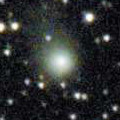
|
It brightened up to 12.1 mag in 2023 spring (May 20, 2023, Jose Guilherme de S. Aguiar). Now it is 17.4 mag (Mar. 25, ATLAS South Africa). It stays 18 mag for a while. In the Northern Hemisphere, it is not observable now, but it will appear in August. It locates somewhat low in the Southern Hemisphere. But it will become high in summer.
Date(TT) R.A. (2000) Decl. Delta r Elong. m1 Best Time(A, h)
May 10 5 49.50 -20 27.9 7.654 7.123 55 17.2 18:36 ( 89, 36)
May 17 5 52.78 -19 49.0 7.755 7.172 51 17.3 18:31 ( 87, 32)
|

|
Now it is 17.8 mag (Apr. 17, Taras Prystavski). It stays 17 mag for a while. It will be unobservable soon in the Northern Hemisphere, or in July in the Southern Hemisphere. But it will be observable again in August in the Southern Hemisphere.
Date(TT) R.A. (2000) Decl. Delta r Elong. m1 Best Time(A, h)
May 10 6 52.72 -5 18.6 4.874 4.458 60 17.3 18:36 (116, 40)
May 17 6 58.74 -5 16.4 4.944 4.456 55 17.3 18:31 (112, 37)
|

|
Now it is 17.4 mag (Sept. 20, Taras Prystavski). It stays 17 mag for a while. It stays observable in good condition.
Date(TT) R.A. (2000) Decl. Delta r Elong. m1 Best Time(A, h)
May 10 21 39.00 0 53.1 3.220 3.240 82 17.3 5:16 (209, 50)
May 17 21 43.65 1 35.5 3.141 3.256 87 17.3 5:21 (198, 52)
|

|
Now it is 18.0 mag (Feb. 2, ATLAS Chile). It stays 17 mag for a while. In the Northern Hemisphere, it is not observable now, but it will appear in July. In the Southern Hemisphere, it will be getting higher gradually. It is expected to brighten up to 13 mag in winter between 2026 and 2027.
Date(TT) R.A. (2000) Decl. Delta r Elong. m1 Best Time(A, h)
May 10 2 17.04 -37 43.2 7.582 7.075 56 17.4 5:16 (301, 22)
May 17 2 22.81 -37 29.5 7.495 7.032 59 17.3 5:21 (298, 27)
|

|
Now it is 17.2 mag (Apr. 28, ATLAS Chile). It stays 18 mag for a while. It stays extremely low in the Northern Hemisphere. But it will become high in autumn. In the Southern Hemisphere, it will be getting lower gradually after this, and it will be unobservable in August. But it will be observable again in August.
Date(TT) R.A. (2000) Decl. Delta r Elong. m1 Best Time(A, h)
May 10 7 35.55 -29 44.1 3.750 3.711 80 17.4 18:36 ( 91, 62)
May 17 7 39.65 -27 18.7 3.827 3.704 75 17.4 18:31 ( 93, 57)
|

|
It returns for the first time in 70 years. It brightened up to 3.7 mag in early April in 2024 (Apr. 6, 2024, Jose Guilherme Aguiar). Now it is 17.9 mag (Mar. 14, ATLAS Chile). Fading slowly. It will be fainter than 18 mag in June. It stays extremely low in the Northern Hemisphere. In the Southern Hemisphere, it stays observable in good condition.
Date(TT) R.A. (2000) Decl. Delta r Elong. m1 Best Time(A, h)
May 10 16 30.21 -51 9.2 4.093 4.933 142 17.4 1:21 ( 0, 74)
May 17 16 21.07 -50 41.5 4.117 4.997 147 17.5 0:45 ( 0, 74)
|

|
Now it is 17.3 mag (Oct. 31, ATLAS Chile). It stays 17 mag for a while. In the Northern Hemisphere, it will be getting higher gradually. In the Southern Hemisphere, it stays observable in good condition.
Date(TT) R.A. (2000) Decl. Delta r Elong. m1 Best Time(A, h)
May 10 23 49.65 -4 47.0 3.798 3.301 53 17.5 5:16 (249, 34)
May 17 23 57.66 -4 5.6 3.722 3.303 58 17.4 5:21 (243, 38)
|

|
It brightened up to 13.1 mag in autumn (Nov. 1, Thomas Lehmann). Now it is 16.6 mag (May 2, Yukihiro Sugiyama). Fading gradually. It will be fainter than 18 mag in June. It stays observable in good condition.
Date(TT) R.A. (2000) Decl. Delta r Elong. m1 Best Time(A, h)
May 10 17 28.56 11 1.3 2.334 3.130 134 17.5 2:19 (180, 44)
May 17 17 18.78 10 5.1 2.346 3.196 141 17.6 1:41 (180, 45)
|
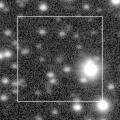
|
Now it is 17.3 mag (May 4, Toshihiko Ikemura, Hirohisa Sato). It stays 18 mag for a while. It stays observable in good condition.
Date(TT) R.A. (2000) Decl. Delta r Elong. m1 Best Time(A, h)
May 10 16 54.14 -22 57.7 5.792 6.716 154 17.6 1:44 (180, 78)
May 17 16 48.35 -22 14.9 5.731 6.703 162 17.6 1:11 (180, 77)
|

|
Now it is 17.5 mag (Apr. 28, Yasukazu Ikari). It stays 18 mag for a while. In the Northern Hemisphere, it stays observable in good condition. In the Southern Hemisphere, it is not observable now, but it will appear in August.
Date(TT) R.A. (2000) Decl. Delta r Elong. m1 Best Time(A, h)
May 10 18 44.07 61 40.3 5.016 5.116 89 17.7 3:33 (180, -7)
May 17 18 28.89 62 34.1 4.987 5.111 91 17.7 2:50 (180, -8)
|

|
It brightened very rapidly. Now it is 17.2 mag (Apr. 27, ATLAS-HKO, Haleakala). Fading gradually. It will be fainter than 18 mag soon. In the Northern Hemisphere, it will be getting lower gradually. In the Southern Hemisphere, it stays observable in good condition.
Date(TT) R.A. (2000) Decl. Delta r Elong. m1 Best Time(A, h)
May 10 10 16.39 2 51.1 1.742 2.236 105 17.7 19:04 (180, 52)
May 17 10 24.42 2 46.4 1.820 2.241 100 17.8 18:44 (180, 52)
|

|
Now it is 17.9 mag (May 5, Alfons Diepvens). It stays 18 mag for a while. It stays observable in good condition.
Date(TT) R.A. (2000) Decl. Delta r Elong. m1 Best Time(A, h)
May 10 17 3.68 16 37.8 4.704 5.469 135 17.7 1:53 (180, 38)
May 17 17 1.71 16 57.9 4.652 5.445 137 17.7 1:24 (180, 38)
|

|
Now it is 17.8 mag (Apr. 17, Taras Prystavski). It stays 18 mag for a while. In the Northern Hemisphere, it will be getting lower gradually. In the Southern Hemisphere, it will never be observable after this.
Date(TT) R.A. (2000) Decl. Delta r Elong. m1 Best Time(A, h)
May 10 8 1.69 54 50.7 5.797 5.470 66 17.9 18:36 (165, -3)
May 17 8 8.19 53 39.8 5.883 5.479 61 17.9 18:31 (162, -2)
|
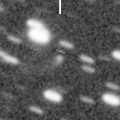
|
Now it is 17.6 mag (Apr. 26, Yasukazu Ikari). It stays 18 mag for a while. It stays observable in good condition.
Date(TT) R.A. (2000) Decl. Delta r Elong. m1 Best Time(A, h)
May 10 19 27.84 15 53.7 4.987 5.380 107 17.9 4:17 (180, 39)
May 17 19 22.42 15 58.0 4.926 5.414 113 17.9 3:44 (180, 39)
|

|
Now it is 16.5 mag (Apr. 19, ATLAS South Africa). It stays 18 mag for a while. It stays observable in good condition.
Date(TT) R.A. (2000) Decl. Delta r Elong. m1 Best Time(A, h)
May 10 20 18.23 -20 49.8 4.238 4.638 107 18.0 5:08 (180, 76)
May 17 20 19.39 -20 23.3 4.156 4.654 113 17.9 4:41 (180, 75)
|
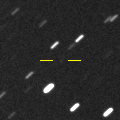
|
It became much fainter than predicted after the perihelion passage. Now it is 20.0 mag (Mar. 12, Taras Prystavski). Fading slowly. It stays observable in good condition.
Date(TT) R.A. (2000) Decl. Delta r Elong. m1 Best Time(A, h)
May 10 20 22.65 -7 30.4 1.750 2.206 102 19.6 5:12 (180, 62)
May 17 20 27.83 -6 40.2 1.695 2.225 107 19.6 4:49 (180, 62)
|

|
It approached to Sun down to 0.11 a.u. on Mar. 9. Now it is 17.9 mag (Apr. 18, ATLAS Chile). Fading rapidly. In the Northern Hemisphere, it will be getting lower gradually. In the Southern Hemisphere, it stays observable in good condition.
Date(TT) R.A. (2000) Decl. Delta r Elong. m1 Best Time(A, h)
May 10 10 9.17 4 59.0 0.861 1.469 103 20.0 18:57 (180, 50)
May 17 10 26.60 4 21.5 1.034 1.575 100 20.5 18:47 (180, 51)
|
|
![]()
 C/2023 A3 ( Tsuchinshan-ATLAS )
C/2023 A3 ( Tsuchinshan-ATLAS ) C/2024 G3 ( ATLAS )
C/2024 G3 ( ATLAS ) 217P/LINEAR
217P/LINEAR 29P/Schwassmann-Wachmann 1
29P/Schwassmann-Wachmann 1 C/2021 G2 ( ATLAS )
C/2021 G2 ( ATLAS ) C/2022 N2 ( PanSTARRS )
C/2022 N2 ( PanSTARRS ) 48P/Johnson
48P/Johnson 49P/Arend-Rigaux
49P/Arend-Rigaux C/2022 E2 ( ATLAS )
C/2022 E2 ( ATLAS ) C/2022 QE78 ( ATLAS )
C/2022 QE78 ( ATLAS ) C/2014 UN271 ( Bernardinelli-Bernstein )
C/2014 UN271 ( Bernardinelli-Bernstein ) C/2024 J2 ( Wierzchos )
C/2024 J2 ( Wierzchos ) C/2023 C2 ( ATLAS )
C/2023 C2 ( ATLAS ) C/2024 L5 ( ATLAS )
C/2024 L5 ( ATLAS ) 65P/Gunn
65P/Gunn 43P/Wolf-Harrington
43P/Wolf-Harrington P/2023 S1 ( PanSTARRS )
P/2023 S1 ( PanSTARRS ) C/2023 T3 ( Fuls )
C/2023 T3 ( Fuls ) C/2023 R1 ( PanSTARRS )
C/2023 R1 ( PanSTARRS ) C/2024 E1 ( Wierzchos )
C/2024 E1 ( Wierzchos ) C/2024 J3 ( ATLAS )
C/2024 J3 ( ATLAS ) 496P/2024 S3 ( Hill )
496P/2024 S3 ( Hill ) C/2023 F3 ( ATLAS )
C/2023 F3 ( ATLAS ) C/2023 H5 ( Lemmon )
C/2023 H5 ( Lemmon ) C/2024 A1 ( ATLAS )
C/2024 A1 ( ATLAS ) C/2022 R6 ( PanSTARRS )
C/2022 R6 ( PanSTARRS ) 47P/Ashbrook-Jackson
47P/Ashbrook-Jackson C/2019 U5 ( PanSTARRS )
C/2019 U5 ( PanSTARRS ) C/2023 Q1 ( PanSTARRS )
C/2023 Q1 ( PanSTARRS ) C/2020 V2 ( ZTF )
C/2020 V2 ( ZTF ) C/2019 E3 ( ATLAS )
C/2019 E3 ( ATLAS ) 88P/Howell
88P/Howell C/2021 S3 ( PanSTARRS )
C/2021 S3 ( PanSTARRS ) C/2019 L3 ( ATLAS )
C/2019 L3 ( ATLAS ) 13P/Olbers
13P/Olbers C/2024 G2 ( ATLAS )
C/2024 G2 ( ATLAS ) C/2020 K1 ( PanSTARRS )
C/2020 K1 ( PanSTARRS ) 195P/Hill
195P/Hill 362P/(457175) 2008 GO98
362P/(457175) 2008 GO98 C/2024 T5 ( ATLAS )
C/2024 T5 ( ATLAS ) C/2024 X2 ( ATLAS )
C/2024 X2 ( ATLAS ) 12P/Pons-Brooks
12P/Pons-Brooks 302P/Lemmon-PanSTARRS
302P/Lemmon-PanSTARRS C/2024 B1 ( Lemmon )
C/2024 B1 ( Lemmon ) C/2024 G6 ( ATLAS )
C/2024 G6 ( ATLAS ) C/2023 V1 ( Lemmon )
C/2023 V1 ( Lemmon ) P/2010 LH155
P/2010 LH155 C/2024 G4 ( PanSTARRS )
C/2024 G4 ( PanSTARRS ) C/2024 N4 ( Sarneczky )
C/2024 N4 ( Sarneczky ) C/2022 U1 ( Leonard )
C/2022 U1 ( Leonard ) C/2023 H1 ( PanSTARRS )
C/2023 H1 ( PanSTARRS ) 105P/Singer Brewster
105P/Singer Brewster (431760) 2008 HE
(431760) 2008 HE![]()


















































